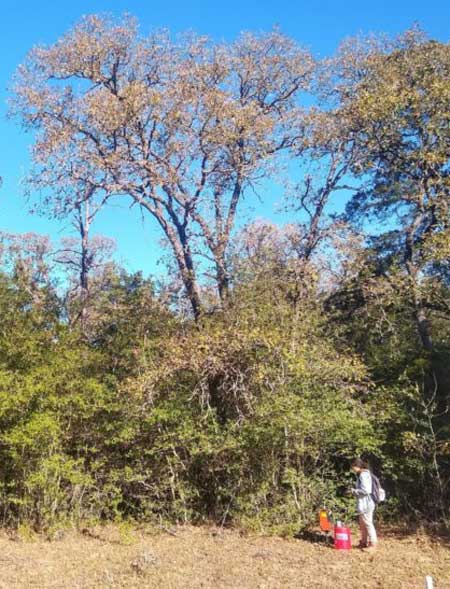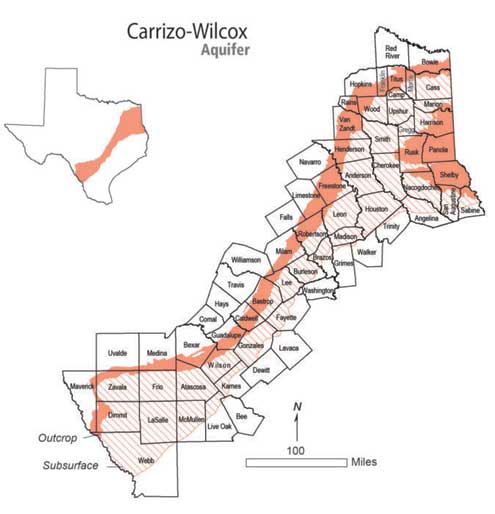AgriLife Research study shows ‘thicketization’ dramatically impacting water levels
The expansion of woody plants across Texas’ Post Oak Savannah is significantly reducing water recharge in the Carrizo-Wilcox aquifer, according to a published article by Texas A&M AgriLife Research scientists.
“Thicketized oak woodlands reduce groundwater recharge,” which appeared in Science of the Total Environment, a journal of natural science, showed that thickets of woody plants such as yaupon and junipers are preventing rainfall from filtering into the aquifer and impacting water recharge rates on regional levels.
Bradford Wilcox, Ph.D., AgriLife Research professor of ecohydrology in the Department of Ecology and Conservation Biology, Bryan-College Station, said the project that produced the published article has broad implications related to water availability and land stewardship throughout Texas.
Over the past 150 years, numerous land-use changes transformed native post oak savanna landscapes. These changes, include cultivation and subsequent abandonment, altered fire regimes, urbanization and land fragmentation. It also allowed undesirable plants, such as yaupon and junipers, to invade the understory, creating dense thickets of vegetation—a process described as thicketization.

The published study stems from an AgriLife Research and the College of Agriculture and Life Sciences project meant to shed light on how changes in land use and the encroachment of woody plant thickets are dramatically reducing groundwater recharge. The three-year project is funded by a $750,000 U.S. Department of Agriculture National Institute of Food and Agriculture grant.
Wilcox’s collaborators include Briana Wyatt, Ph.D., soil scientist in the Department of Soil and Crop Sciences; and Jason West, Ph.D., plant physiologist, and Sorin Popescu, Ph.D., professor of remote sensing, both in the Department of Ecology and Conservation Biology. They also include a team of graduate students, including post-doctoral scientist Shishir Basant, ecohydrology, who was the publication’s lead author, and doctoral candidates Horia Olariu, remote sensing, and Mingxiu Wang, modeling, are conducting the study.
“The study demonstrated that thicketization in the overlying recharge zone along the Post Oak Savannah allowed basically zero recharge into the aquifer and strongly suggests that the substantial change in vegetation along those sandy formations is impacting water levels in a major groundwater source,” he said. “There had been some anecdotal evidence suggesting this might be happening, but now we have documented evidence.”
Carrizo-Wilcox historically important
The Carrizo-Wilcox Aquifer has long been utilized by private well owners, municipalities, agricultural producers and industry. It is the third most important groundwater resource in Texas after the Edwards and the Ogallala aquifers.

Recoverable water storage in the Carrizo-Wilcox Aquifer is estimated to be between 1.3 billion to 3.9 billion acre-feet. An acre-foot is the amount of water needed to cover 1 acre of land with water 1 foot deep, almost 326,000 gallons. By comparison, Toledo Bend, the largest surface-water reservoir in Texas, was designed for a total storage capacity of 4.6 million acre-feet.
The aquifer’s water table has dropped more than 150 feet over the past several decades.
As land-use change and fragmentation continues to accelerate, Wilcox worries thicketization will worsen unless landowners and policymakers are made aware of its negative impacts.
The study will continue with assessments of other locations along the Post Oak Savannah conducted by Basant and a closer analysis of the data by Olariu and Wang to refine the extent of thicketization along the aquifer’s recharge zone. Researchers also want to determine how quickly thicketization expanded across the region over the past 40 years.
“Now that we know thicketization is impacting aquifer recharge rates, we will look at other sites and determine what percentage of the recharge zone is in a thicketed state,” Wilcox said. “It appears woody brush is expanding, but closer analysis puts us in a stronger position to provide evidence of thicketization that might provide impetus for coordinated restoration efforts within the Post Oak Savannah.”